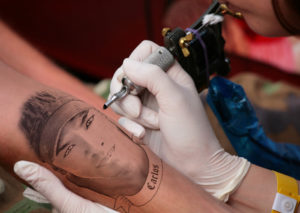
Sarah Ann? She’d do this in a heartbeat!
Tattoo comes from the Samoan word tatau, “to strike,” which refers to the repetitive punctures needed to allow pigments to penetrate the skin. Tattooing is an ancient art form: Egyptian mummies dating back to 3351 B.C. sported tattoos, and Ötzi, “The Iceman,” found frozen in the Alps, had 61 tattoos, mainly linear ones on his legs. Tattoos were most widely practiced by ancient Austronesians, using thorns or shards of obsidian, bone or oyster shells. Modern machines, in contrast, have single-use needles that are driven into the skin at 150 times a second.
European awareness of tattooing was raised by the sordid kidnapping of an Inuit mother and child by French sailors in 1556. The pair were displayed in taverns, probably contributing to future acquisition of tattooed people. The most famous was “Jeoly, the Tattooed Prince,” who was a slave bought in the Philippines with his mother in 1590. His intricate tattoos caused a sensation, but he died of smallpox three months later.
Captain Cook’s voyages to the South Pacific in the late 18th century rekindled interest in tattoos. His expedition botanist got a tattoo, and a French Polynesian man with tattoos was also presented at court, which precipitated an upswing in tattoos among the aristocracy as a status symbol, since artfully done tats were expensive, as opposed to the crude marking of criminals.
The first professional tattoo artist in the U.S. was a German immigrant, who traveled from camp to camp, inking Union and Confederate soldiers alike. This helped start the tradition of military members getting tattoos. For others, the rarity of professional artists meant getting a tattoo was an expensive undertaking, so it became popular among upper-class fashionable adults after the Civil War. Once the electric tattoo machine was invented and the financial barrier was removed, tattoos lost their appeal as status symbols, and instead developed the reputation of being associated with criminals and rebels, and to this day, many workplaces require that tattoos be covered.
Current generations view tattoos as a form of self-expression, which is removing the stigma, as well as any Bad Boy symbolism. In 2008, a U.S. survey found that 14% of adults had tattoos, though it was 32% in the 25-29 age group.
Tats can be accidental or traumatic, when flakes of ground metal are embedded into the skin in industrial work, asphalt in a wound, or a pencil or pen jabbed into skin.
Tattoos have been used in identification of criminals, deserters, and runaway slaves as far back as the Roman Empire. In Chinese and Japanese society, the association with criminals made tattoos taboo. Prisoners were infamously marked in Nazi concentration camps, and gang members use tattoos as a form of identity. American sailors used to carry “Protection Papers,” which were meant to prevent their being pressed into service if captured by another nation. These gave a general description of a sailor, and to be more specific, tattoos were described, leading many sailors to get inked as one more measure to prove identity. These papers also served to prove status as freemen, so Black sailors often chose tattoos to help ensure they could not be captured and enslaved.
Medical tattoos include radiation tattoos, which are simply tiny dots to indicate the edges of radiation fields. Some families choose to tattoo family members suffering from dementia with their names, in case they wander away, to help with identification. The Waffen-SS had tattoos indicating their blood type, and since this was presumptive evidence of their Nazi association, after the war, many ex- Waffen-SS members shot themselves through the arm to remove the tattoo. Some modern patients choose to tattoo “Do Not Resuscitate” on their chests, but it’s not recommended, since medical personnel cannot be bound by a tattoo of indeterminate age.
Cosmetic tattoos include permanent eyeliner or lip color, tattoos of areolas in breast reconstruction, and covering of scars or inadvisable earlier tattoos. It’s the excellent camouflage tattoos provide that make me less enthused about tattoos on hunky cover models—all those ripped muscles are obscured by ink.
Though work done without safeguards can spread hepatitis and HIV, tattoos are usually innocuous, though occasionally horrific infections or allergic reactions can result. Red, pink, and purple ink are particularly risky for the latter. Tattoo removal used to be an imperfect affair, leading to smudges, but laser removal is much better, sometimes able to completely remove embedded ink, though not always. In addition, scarring from the initial application may be permanent, though the pigment is gone. So, think twice, and don’t tattoo drunk!
So what do YOU think of tattoos?
Free on Amazon 1/15 & 1/16: Submerged Hopes:

Deaf archaeologist Nerissa’s excavation of an ancient shipwreck uncovers priceless artifacts, stirring the ghosts of her past and the jealousy of colleagues, She falls hard for her interpreter, who’s happy to bed her but can she count on him in the wreck’s spectacular enough to provoke murder?
Interesting info!
Fascinating, no? Thanks for reading!